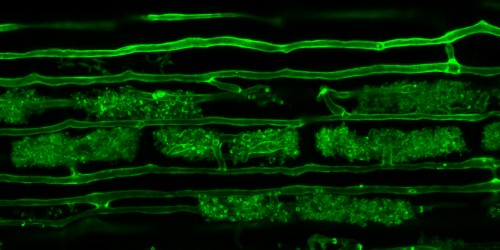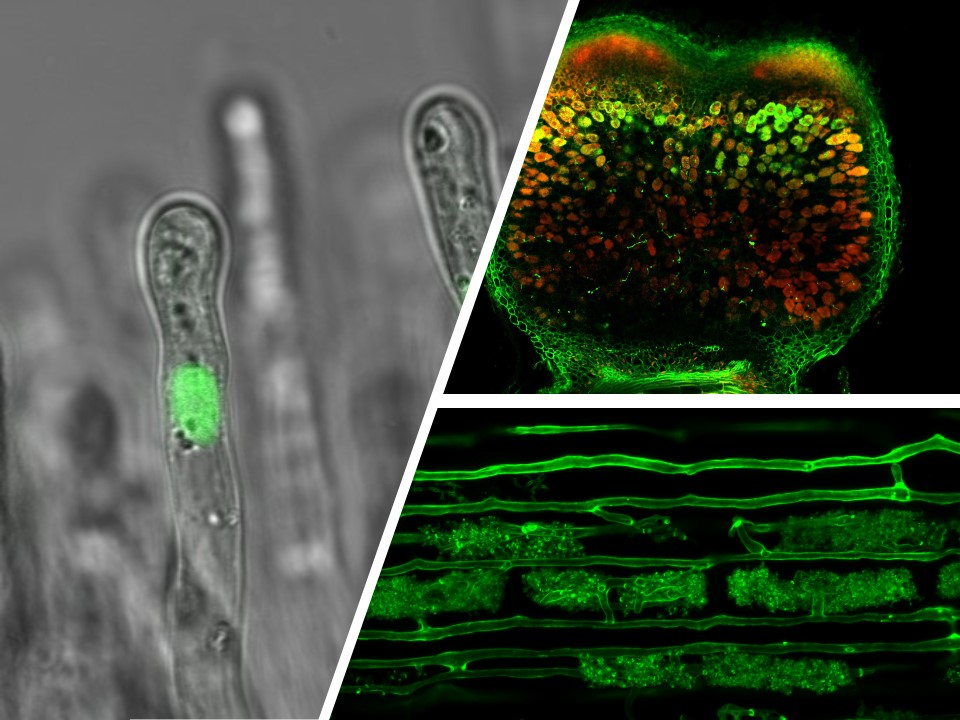Norwich, United Kingdom
January 15, 2025

Researchers have discovered a biological mechanism that makes plant roots more welcoming to beneficial soil microbes.
This discovery by John Innes Centre researchers paves the way for more environmentally-friendly farming practices, potentially allowing farmers to use less fertiliser.
Production of most major crops relies on nitrate and phosphate fertilisers, but excessive fertiliser use harms the environment.
If we could use mutually beneficial relationships between plant roots and soil microbes to enhance nutrient uptake, then we could potentially reduce use of inorganic fertilisers.
Researchers in the group of Dr Myriam Charpentier discovered a mutation in a gene in the legume Medicago truncatula that reprogrammes the signalling capacity of the plant so that it enhances partnerships with nitrogen fixing bacteria called rhizobia and arbuscular mycorrhiza fungi (AMF) which supply roots with phosphorus.
This type of partnership, known as endosymbiosis, where one organism exists within another, enables legume plants to scavenge nutrients from the soil via microbes, in exchange for sugars.
A barrier to the widespread use of endosymbiotic partnerships in agriculture is that they preferentially occur in nutrient-poor soils, conflicting with the conditions of intensive farming.
In this study which appears in Nature, experiments showed that the gene mutation in a calcium signalling pathway enhances endosymbiosis in farming conditions.
Excitingly, the team used genetic approaches to show that the same gene mutation in wheat enhances colonization by nitrogen fixing bacteria and AMF in field conditions too.
 Left, Medicago truncatula root hair with flourescent cell nucleus; top right dye-stained root nodule, the site of nitrogen fixation; bottom right – stained image of arbuscular mycorrhizal fungi – Credit – Edmund Bridge.
Left, Medicago truncatula root hair with flourescent cell nucleus; top right dye-stained root nodule, the site of nitrogen fixation; bottom right – stained image of arbuscular mycorrhizal fungi – Credit – Edmund Bridge.
The findings represent an exciting breakthrough in the long-held ambition to use enhanced endosymbiotic partnerships as natural alternatives to inorganic-fertilizer across major crops, including cereals and legumes.
“Our findings hold great potential for advancing sustainable agriculture. It is unexpected and exciting that the mutation we have identified enhances endosymbiosis in farming conditions, because it offers the potential for sustainable crop production using endosymbionts alongside reduced inorganic fertiliser use,” said Dr Charpentier.
“The discovery contributes broadly to research on calcium signalling while also offering a transition solution towards more sustainable production of economically important crops.”
Previous research by the Charpentier group has shown that the calcium signalling in root cell nuclei is essential for the establishment of root endosymbiosis with useful nitrogen fixing bacteria and AMF.
This study decodes that key signalling mechanism, showing how calcium oscillations regulate the production of compounds called flavonoids which enhance endosymbiosis.
“Our discovery underscores the importance of fundamental science in addressing societal challenges,” concluded Dr Charpentier.
Root endosymbiosis is highly beneficial to plants, increasing nutrient uptake and stress resilience. There is an increasing need to develop high-yielding, disease resistance crops and reduce fertiliser use to protect the environment as well as reduce costs for farmers.
Combining disease resistance and climate resilience with efficient nutrient assimilation through improved association with symbiotic microorganisms is a key element of this ambition.
Autoactivate CNGC15 enhances root endosymbiosis in legume and wheat appears in Nature